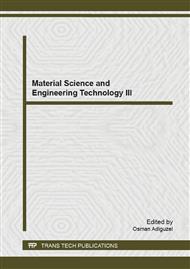p.70
p.75
p.79
p.85
p.89
p.93
p.99
p.104
p.108
Experimental Studies on CNT Reinforced Aluminum Matrix Nanocomposites
Abstract:
The remarkable high tensile strength and very high aspect ratio of carbon nanotubes make them valuable components for mechanically reinforced composite materials. In this study, Carbon Nanotube (CNT) reinforced aluminum matrix composites were prepared by simple stir casting route with different percentages of Carbon Nanotube reinforcement. The prepared nanocomposite specimens were subjected to evaluation of mechanical properties and microstructure. It was evident from the study that, as the weight fraction of nanotube in the matrix increases, the ultimate tensile strength, macro and micro-hardness also increases. The microstructures show clustering of the carbon nanotubes in the matrix. The difficulties experienced in uniform dispersion of Carbon Nanotube in the matrix to achieve optimum desired properties are discussed.
Info:
Periodical:
Pages:
89-92
Citation:
Online since:
April 2015
Authors:
Keywords:
Price:
Сopyright:
© 2015 Trans Tech Publications Ltd. All Rights Reserved
Share:
Citation:


